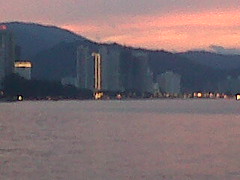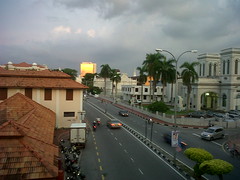.
Rule number one in this Thai monkey town: lock up your cars and close your windows. A clan of monkeys is causing mayhem to a truck parked on the grounds of a 10th-century Khmer Pra Prang Sam Yot shrine. One monkey twists off a side mirror, and tosses it on the ground with simian angst. While another monkey is polishing off the dregs of a Red Bull, before smashing it through the windscreen.
These naughty long-tailed macaques are a few of the 1000-urban dwelling monkeys that that live at Lopburi, 150km north of Bangkok, a former capital of Siam. And they are the guests of a bizarre buffet which is both a brief and a frenzied affair that would even have the Mad Hatter's head spinning by all the monkey business going on.
Inhabited since the Dvaravati period (6th to 11th Century), Lopburi's history span's over 12 hundred years. The old section of Lopburi is studded with ruins from the Khmer empire and a 17th-century palace.
Locals ambivalently see the monkeys both as godsends and miscreants. As the legend goes, it's believed that the animals are incarnate of Hanuman, the Monkey God of the Indian Ramayana who is believed to reside at the two picturesque Khmer ruin of Sam Prang Yod and the nearby shrine of San Pra Kan, known as monkey HQ.
To give you an idea of how revered they are, monks perform Buddhist funeral ceremony rites for the deceased monkeys where their ashes are buried in urns at the monkey graveyard in the nearby Lopburi Zoo.
Today, over 2000 foreign and Thai tourists have turned up in droves to witness a trumped up version of the Teddy Bear's Picnic - a shameless nosh-up for the resident monkeys who will consume over 2,000kg of fruits and vegetables.
Traditionally held on the last Sunday of November, the monkeys perform hi-jinks of sorts at a 'tea party' that volunteers have arranged in their honor - paying their respect to the monkeys who have been instrumental in generating tourism for this town.
It would be easy to believe that the city was built for them. All the power lines are protected with blue PVC piping to prevent any unwanted electrocutions and bad press. And the antennas of houses surrounding the city's shrine are also fitted with foil to prevent the monkeys from disturbing the residents TV viewing.
There's no doubt, however, that for the business community, these monkeys translate as a cash cow. For the 17th Monkey Party, Lopburi Inns hotelier, Yongyuth Kijwattananuson, who started the festival back in 1989, informs the press that this year , "there will be over three tones of food, prepared by six chefs, served by 30 food bearers, and 25 traditional Thai dancers."
His karma abiding outlook towards the city-slicker monkeys has not only brought fame to the town, but a lot of merit for Yongyuth, whose logo of his Lopburi Inn is, coincidently, a monkey. "As Buddhists, we believe we must show compassion to everyone," he explains, as he points at the monkeys behind him that are licking blocks of ice containing fruit and vegetables. "If we take care of the monkeys, good luck and prosperity will be returned by our merit making."
Giant ice bars containing fruit and vegetables are placed around 10-th century Khmer temple of Sam Prang Yod like a mini Stone Hedge. This is the entrée to the main event, and novel to this year's festival. The crab eating monkeys are licking at the ice slabs curiously, while tourists snap away at this bizarre sight.
The red-skirted tables are laden with fruit platters - Thai sweets, confectionaries, and cans of Coca Cola - that are placed around the three pronged temple. The organizer announces over the speakers that the 17th Monkey Party, sponsored by Coca Cola and the Lopburi Inn, has begun.
A few timid monkeys scuttle over the ancient ruins towards the banquet. It's a dismal attendance. Because of the presence of thousands of tourists, loud speakers, and the media with their telescopic lenses, this year many of guests of honor have boycotted the event.
The only thing missing are waiters in bow ties, but I suppose that gimmick will be exploited next year. Previous years, this festival was heavy on nutritious food - pineapple, bananas, papaya, and other tropical fruits. But this year, processed foods seem to be the flavor
The monkeys, however, have not disappointed the throngs of tourists today. It's only five minutes into the feast, and it's now not a pretty sight. Two monkeys are copulating on one table. While on another, there's an all out brawl by a mad mob of monkeys who are fighting over a Coke. Peace is restored when the staff places a new round of drinks on the table.
What's most striking about the displays of these primate, says Warren Reinhart, 22, a Canadian tourist is their uncanny resemblance to their closet relatives. "It was difficult to discern the monkey's from the tourists," he says. "Not only were the monkey's throwing garbage all over the place, but it also set the tone for the tourists who were littering with abandon."
But these are the rights of deities, and don't the monkeys of Lopburi know it?
On any given day, tourists can be seen gawking at monkeys swinging across power lines, hanging off shop eaves, and generally, loitering on street corners in gangs, waiting for any unsuspecting tourist.
A new victim, a middle aged Thai tourist, walks across the road, carrying her grocery bags. She must be a day-tripper and totally unaware of what's about to happen. Like a well orchestrated maneuver, the male of a gang of five monkeys quickly lunge at her. Then the others follow the leader's cue. Eggs, fruit and cakes sprawl onto the pavement. Before she knows what's happened, the marauding monkeys have fled with their loot.
A block away from Sam Prang Yod shrine, old lady sets up her stall in the market - bamboo sticks and sling shots accompanied with bags of stones. She tells me that only last week a local had her bag stolen by a monkey who got away with three credit cards and 5000 baht ($130).
This is the side of Lopburi that doesn't get too much news coverage. She says that there is a demand for her merchandise. "Mostly from food vendors who set up shop near the tourist temples," she explains. "They are sick of the monkeys terrorizing their stalls."
If only Dave Squires, 42, an American tourist, had wondered across these monkey wares a block away. Instead, he got a souvenir of the town that he could have done with out. He says a pack of monkey's jumped him. "The male, the head of this clan, just bit into my shoulder." He had to have a tetanus shot.
"It's one thing to look at them through bars at a zoo - admiring them safely from the other side," adds the English teacher, who has been working at a secondary school in Lopburi for the past year. "But it's another thing to be amongst them - face to face. These are the dangers of being in close proximity to wild animals."
It's late afternoon, and the festival is winding down. It's now business as usual.
Rubbish is strewn over the temple grounds, and the VIP's have apparently pissed off to the Lopburi Inn for a few congratulatory rounds of Monkey Beer, that is brewed on the premises.
A temple boy, who calls himself Pornchai, offers to chaperone me around the temple for a modest fee of 100 baht (A$3.00), for what he says "a hassle free tour of the temples." And now I see his point. As a horde of monkeys advance, eyeing off my Coke I'm holding - I've already had one can snatched from me today - . Pornchai aims his slingshot at the leader of the clan who is now shrieking and retreating.
"Keeps them alert," he says, without any trace of embarrassment. "Lets them know who is boss." 























